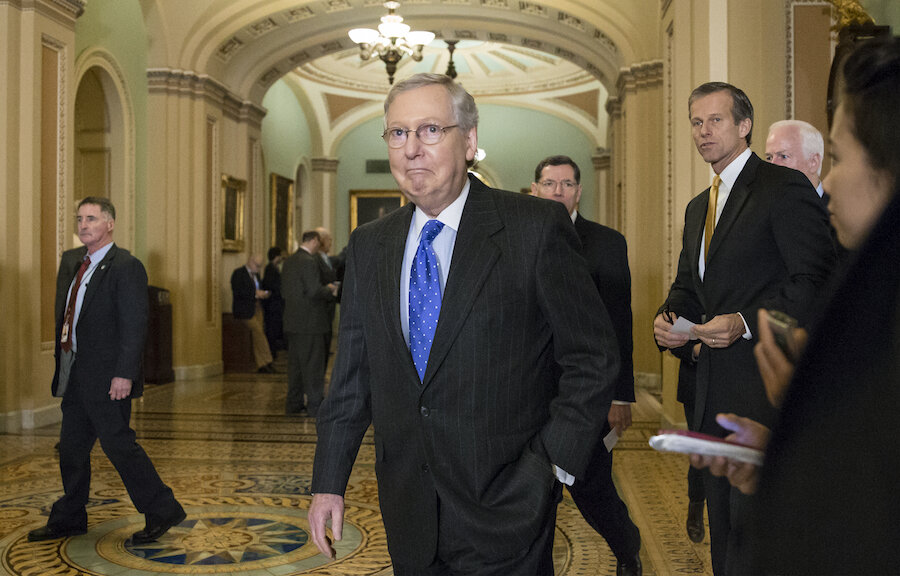The hidden agenda behind the tax extender bill
Loading...
While Republican presidential hopefuls were debating in Las Vegas, congressional leaders announced they had agreed to restore and extend dozens of special interest tax cuts—many permanently. And those GOP candidates for the White House? They’ve promised to repeal nearly all of the tax breaks congressional leaders worked so hard to restore.
What is going on here? Why would House Speaker Paul Ryan and Senate Majority Leader Mitch McConnell put so much effort into making permanent a package of tax breaks that could be back on the chopping block a year from now?
Like much of what happens in Congress, it’s all about budget accounting. And in this case, it turns out you can buy bigger tax rate cuts by repealing permanent tax breaks than by swapping out temporary versions of the same subsidies.
I’ll explain why in a minute. But first, here’s a quick rundown on what the congressional leadership proposed:
First, they’ve proposed to make permanent about two dozen tax subsidies including:
- Enhanced versions of the Child Tax Credit, the Earned Income Tax Credit, and the American Opportunity Tax Credit. Without congressional action, these would have been replaced with less generous versions after 2017.
- Itemized deductions for state and local sales taxes.
- A package of incentives for charitable giving, including a provision that allows tax-free contributions from IRAs.
- The research credit.
- Expensing for small business capital investment.
- A provision that allows U.S. based multinational corporations to defer tax liability on income they earn from “actively financed” foreign investments.
The proposal would extend through 2019 four other tax breaks, including a measure that allow firms to take more generous depreciation for capital investments.
Finally, it would extend 30 more tax breaks through the end of next year, thus likely insuring another extender debate in a post-election lame duck session. Most are highly targeted to specific industries and include a long list of energy-related tax breaks.
The budget deal also delays for two years taxes that were included as part of the 2010 Affordable Care Act, including the so-called Cadillac tax on high-cost employer sponsored health insurance plans and separate taxes on medical device makers and insurance companies.
What to make of all this?
It is on balance a good thing that Congress has, at least for some provisions, ended its long-running tax-extender comedy. By now, you know the tiresome game: Each year, it temporarily extends dozens of tax subsidies. Then, a year or two later, after much drama, lawmakers agree to keep the spigot open for another year. In the case of subsidies such as the research credit, this has been going on for decades. The game keeps lobbyists employed and fills the campaign coffers of incumbent lawmakers. There is, however, little evidence that these subsides contribute in any way to economic growth.
Then there is the tax reform game. It is played like this: The Congressional Budget Office and the Joint Committee on Taxation score tax bills over 10 years. Thus, for instance, permanently extending the deduction for state sales taxes would add $42 billion to the debt over a decade. But extending the deduction for just one year would add only $3.5 billion to the debt over 10 years. That ability to low-ball the official 10-year cost helps explain why lawmakers preferred those one-year extensions.
But say you want to cut tax rates starting in 2017 and promise to partially pay for those rate cuts by eliminating tax subsidies, including this one. If Congress extends it for just one year today, you get no revenue benefit from repealing it, since it expires by 2017. But if Congress makes the deduction permanent, proposing to repeal it would buy you another $40 billion to pay for your rate cuts.
The research credit is a special case. Most GOP presidential hopefuls do want to make that one permanent. By beating them to the punch, Congress would reduce the cost of the candidates’ tax plans by about $113 billion over a decade, leaving more room for more rate cuts.
There are plenty of other problems with this package. The biggest, of course, is that it isn’t paid for. JCT estimates the tax measures would add about $670 billion to the debt over 10 years, excluding added interest costs. Yet, somehow Congress decided that extenders can be extended at no cost. But, make no mistake, the Treasury will still have to borrow more money to make up for this lost revenue.
Then, there is the matter of the substance of many of these tax breaks. Most are the very definition of special interest subsidies. Among the beneficiaries: makers of hard cider, lumber companies, racehorse owners, operators of NASCAR racetracks, and movie producers.
Other extenders have long since lost their reason for existence. Many were first enacted as part of the stimulus bill passed in the teeth of the 2008 economic meltdown. Maybe they served some purpose. But the economy is producing a net 200,000 new jobs a month and the Federal Reserve is starting to raise interest rates. If the Fed can acknowledge that the economy is back on its feet, maybe Congress could too.
This article first appeared at TaxVox.







